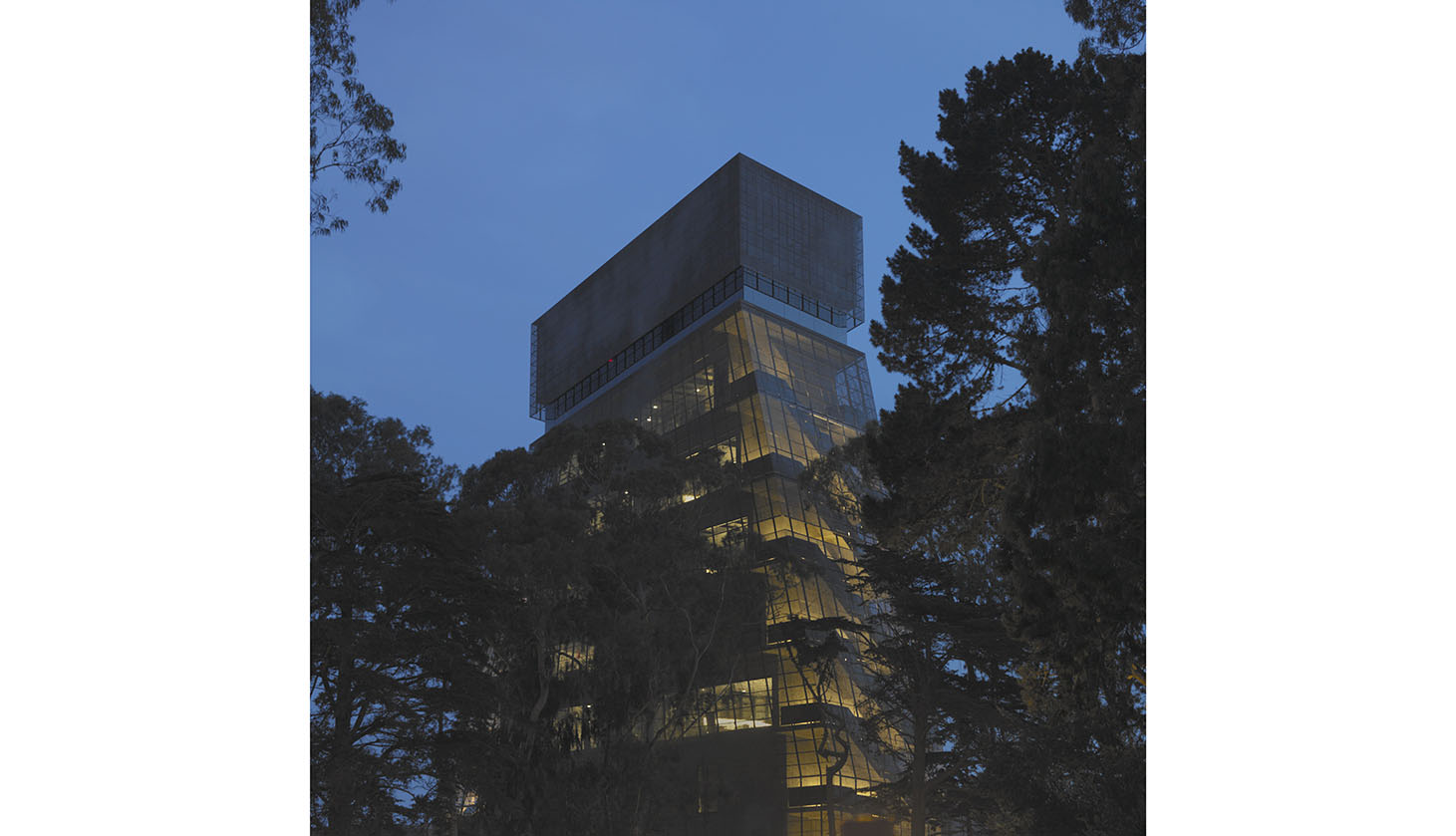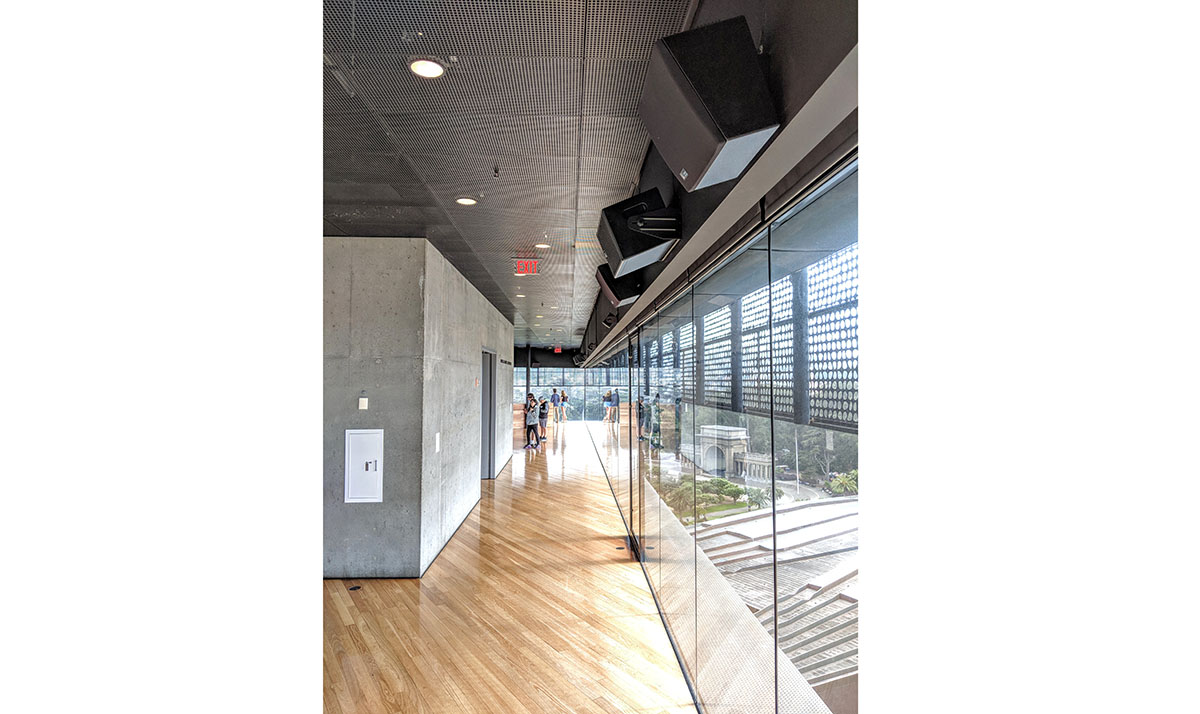At San Francisco’s De Young Museum in the heart of Golden Gate Park, the Hamon Observation tower rises from the building’s angular, copper-clad facade in stark geometric relief against the tree canopy below. Nine stories up, a glass-walled space offers sweeping panoramas of the city neighborhoods, Golden Gate bridge, the bay, and beyond to the Pacific Ocean, giving visitors a unique perspective in this city of hilly urban vistas.
This summer, the observation deck experience took on a new dimension with the commissioned work The Companions: Sounds for a Lost Screenplay, a “cinematic audio environment” created by Skywalker Ranch sound designers Gary Rydstrom and Josh Gold, working in collaboration with visual artist Anthony Discenza.
Inspired by Discenza’s research into the history of The Companions, an unrealized screenplay from the early 1980s, the 20-minute work explores sound’s role in shaping film narrative. Using immersive and directional sounds, the installation moves visitors through themes and atmospheres of The Companions, using the tower’s views as filmic “frames” supported by immersive soundtracks played back through a Meyer Sound system.

Discenza, interested in exploring ways that sound shapes visual perception in film, he approached Rydstrom and Gold with the idea to create a realization of the screenplay, using only sound design elements. Rather than working to a rough cut of a film, Rydstrom and Gold were to create sound that suggested visuals and actions for a narrative as outlined by Discenza.
Rydstrom, an Academy Award-winning sound designer whose credits include Saving Private Ryan, Titanic, Jurassic Park, and Terminator 2: Judgement Day, says he was up for the challenge: “After working on so many films, the notion of developing a sonic environment for an unmade film was really appealing to me, in that it gave me an opportunity to illuminate the enormous role sound plays in film—without having to be tied to any images.”
“On one level, my job was exactly the same as always: to support the narrative,” adds Gold, whose filmography includes Avengers: Infinity War, Rogue One: A Star Wars Story, and Brave. “That’s because movies are inherently visual experiences, whether the scenes unfold on the screen or, as here, in one’s imagination. I just had to tune into my own brainwaves any time I needed the answers that the visual elements usually provide.”

Referencing classic films set in San Francisco such as Vertigo (1958) and Invasion of the Body Snatchers (1979), the work wove together 1,500 sound elements, drawn from recordings in Skywalker Sounds’ vast sound effects library as well as 200 newly recorded effects gathered from location recordings around San Francisco. Sound selection, editing, and pre-mixing took place at Skywalker; the pre-mix, recorded on Pro Tools and encoded in DTS-X, was taken to the Hamon Tower for final mixing.
The tower’s Meyer Sound playback system included two mirror-image systems, each with LCR main channels and surrounds, that cover the “action” as it shifts across the space during the course of the movie narrative. The entire system comprises 12 Meyer Sound HMS-5 surround loudspeakers, six MM-4XP miniature loudspeakers, and six MM-10XP subwoofers. The Meyer Sound system met the project’s requirements for a playback system to deliver a full-range, immersive cinema sound experience with minimal visual impact, says Skywalker Sound engineer Brian Long. “The Meyer Sound loudspeakers were selected based on their ability to fulfill the technical performance requirements within a low-profile visual aesthetic.”
According to Josh Gold, the effect of the soundtrack translated very well from the studio into a non-cinematic acoustical setting. “The results achieved with the Meyer Sound system are fantastic,” he says. “This had everything to do with the collaboration between Skywalker and the engineers on the Meyer Sound team. Also, fortunately, the glass-walled environment was kinder than I had expected it to be!”
Sarah Jones is a writer, editor, and content producer with more than 20 years' experience in pro audio, including as editor-in-chief of three leading audio magazines: Mix, EQ, and Electronic Musician. She is a lifelong musician and committed to arts advocacy and learning, including acting as education chair of the San Francisco chapter of the Recording Academy, where she helps develop event programming that cultivates the careers of Bay Area music makers.